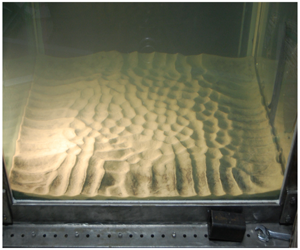Article contents
Sediment suspension and bed morphology in a mean shear free turbulent boundary layer
Published online by Cambridge University Press: 29 April 2020
Abstract

We experimentally characterize turbulence in boundary layers generated by different levels of nearly isotropic homogeneous turbulence over flat impervious boundaries and over non-cohesive sediment beds with and without ripples. We use randomly actuated synthetic jet arrays (RASJA – Variano & Cowen, J. Fluid Mech., vol. 604, 2008, pp. 1–32) to generate high Reynolds number ( $Re_{\unicode[STIX]{x1D706}}\sim 300$) turbulence with negligible secondary mean flows or mean bed shear. The isotropic region and the boundary layer connecting this isotropic region to the bed are investigated using particle image velocimetry measurements. Surprisingly, we observe the development of ripples on the sediment bed (
$Re_{\unicode[STIX]{x1D706}}\sim 300$) turbulence with negligible secondary mean flows or mean bed shear. The isotropic region and the boundary layer connecting this isotropic region to the bed are investigated using particle image velocimetry measurements. Surprisingly, we observe the development of ripples on the sediment bed ( $D_{50}=260~\unicode[STIX]{x03BC}\text{m}$). We draw comparisons between the mean shear free turbulent boundary layer formed above a flat stationary solid boundary (Johnson & Cowen, J. Fluid Mech., vol. 835, 2018, pp. 217–251) and its sediment counterpart by considering statistical metrics including root mean square velocity fluctuations, turbulent kinetic energy, dissipation rates, production, integral scales, Reynolds stresses and spatial spectra. Using an 8 × 8 RASJA, we find the damping of turbulence and dissipation rates at flat and rippled sediment beds with low levels of suspended sediments relative to an impermeable glass bed, whereas with a 16 × 16 RASJA we find the enhancement of turbulence and dissipation rates of a resuspending sediment bed relative to an impermeable glass bed. We hypothesize that this may be a result of a change in direction of the bed-normal mean flows at the porous boundary. We explore a relationship between the integral length scale of the turbulence with the resulting sediment ripple spacing by varying the mean on-time of the RASJA algorithm.
$D_{50}=260~\unicode[STIX]{x03BC}\text{m}$). We draw comparisons between the mean shear free turbulent boundary layer formed above a flat stationary solid boundary (Johnson & Cowen, J. Fluid Mech., vol. 835, 2018, pp. 217–251) and its sediment counterpart by considering statistical metrics including root mean square velocity fluctuations, turbulent kinetic energy, dissipation rates, production, integral scales, Reynolds stresses and spatial spectra. Using an 8 × 8 RASJA, we find the damping of turbulence and dissipation rates at flat and rippled sediment beds with low levels of suspended sediments relative to an impermeable glass bed, whereas with a 16 × 16 RASJA we find the enhancement of turbulence and dissipation rates of a resuspending sediment bed relative to an impermeable glass bed. We hypothesize that this may be a result of a change in direction of the bed-normal mean flows at the porous boundary. We explore a relationship between the integral length scale of the turbulence with the resulting sediment ripple spacing by varying the mean on-time of the RASJA algorithm.
- Type
- JFM Papers
- Information
- Copyright
- © The Author(s), 2020. Published by Cambridge University Press
References
- 10
- Cited by




